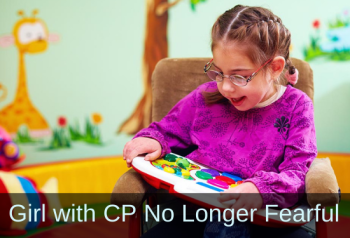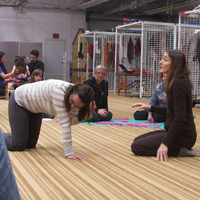PT Assistant Says: “It’s Hard to Believe” the Huge Impact of Reflex Integration
Submitted by R.M., Physical Therapy Assistant

|
Before
|
After
|
|
Would often hold her breath, yell for help, raise her arms letting go of support surfaces, and collapse into flexion when trying to stand if when not fully supported
|
Able to maintain standing balance with only her back against a wall, without support by a therapist, for more than 2 minutes
|
|
Had difficulty with sitting balance and would require her hands and anterior trunk leaning on a support surface or support at her ribcage for security, in large part due to fear of falling and tensing up
|
Able to balance while sitting without her feet supported for over 5 minutes
|
|
Was often very shy or easily embarrassed and would lose focus and visual control when overwhelmed
|
Can now really focus on what is happening around her and engage with friends, rather than shifting her focus internally with constant worry about her security and safety
|
|
Would often perseverate on her schedule
|
More flexible with her session scheduling
|
I have been seeing a 6 y.o. girl for physical therapy for 1 session per week for the last few years. She is diagnosed with cerebral palsy and presents with spastic quadriplegia. She has a Moro response to loud or sudden noises, even when the noise is anticipated such as from an interactive puzzle. She also has gravitational insecurity and becomes very anxious and fearful of falling when attempting to balance independently. She will often hold her breath, yell for help, raise her arms letting go of support surfaces, and collapse into flexion when trying to stand if she does not feel fully supported. She enjoys some vestibular input selectively but will generally request to stop the preferred activity after a few times and has experienced motion sickness. She can be very shy or easily embarrassed at times and loses focus and visual control when overwhelmed. She has difficulty with sitting balance and would require her hands and anterior trunk leaning on a support surface or support at her ribcage for security, in large part due to fear of falling and tensing up. She would become very fearful when asked to sit independently, even in criss cross sitting, and would fall over without protective extension of her upper extremities to catch herself, in part due to tension throughout her arms and neck from fear.
We have been working on integration of the Fear Paralysis Reflex and Moro Reflex [from the Brain and Sensory Foundations course] to help her remain calm and focused to improve her balance and emotional regulation. We have also been working on developing her Head Righting Reflex to assist with balance, neck strength, and eye muscle control.
At the start of every session we perform all of the innate rhythmic movements with a focus on her head positioned in midline and neck relaxed to allow for head nodding. Initially this was very difficult for her but after a few weeks she began to allow her neck to relax and experience the rhythmic movement. She still has difficulty maintaining her head in a midline position but she is now able to correct it briefly with only verbal cues.
We always do the 5-step balance Process [from the Brain and Sensory Foundations course] where I have her verbalize her goal of improved balance, then we practice standing balance when transferring out of her wheelchair to stimulate the reflexes. We then stimulate the fear paralysis reflex further by tapping along her side body in the fetal position. She would jump or laugh during this activity initially but now tolerates this well without a response most of the time.
We work on stimulation and integration of the Moro reflex with “Roly Poly” and “Big Star” movements with assistance to tuck her legs. She initially also required maximal assistance to lift her head, but now is able to perform an active chin tuck for a full 7 seconds. We perform the head righting activity [from the Brain and Sensory Foundations course] with some modifications in supine due to low tone in her trunk and difficulty with active sitting. I would provide gentle isometrics to her head and ask her to maintain her head in midline. She was unable to perform this activity when we first started, allowing her head to move with no active resistance against the pressure.
Now she is able to perform these isometric holds for nearly 7 seconds at a time without compensatory neck rotation. After the integration work I assist her in performing the support repatterning sequence in supine although she rarely is able to control her visual focus during the activities. The reflex work is then followed by functional activity, her goals, such as sitting balance in various positions and standing balance with various types of support.
This [Brain and Sensory Foundations] program was used for approximately 9 months. She is now able to maintain standing balance with only her back against a wall without support by a therapist for more than 2 minutes! She only requires verbal cues to breathe and press her back into the wall to encourage upright posture and engage her extensors. She is also able to balance while sitting without her feet supported for over 5 minutes while maintaining upright posture and can perform visual tracking and reaching across midline in this position without loss of balance. She is even able to reach out and catch herself with her right arm at times since she is not as fearful of falling. She can balance freely to engage in activities using her upper extremities without help and without becoming nervous. I have noticed that she has become more outgoing and enjoys engaging with peers and does not worry as much about falling. She is able to be flexible with her sessions and does not perseverate on her schedule like she used to. It has been amazing watching her enjoy activities that were once very scary to her. It is hard to believe how much of an impact these reflexes have had on her. She can now really focus on what is happening around her and engage with friends rather than shifting her focus internally with constant worry about her security and safety.
(Emphasis Added)


